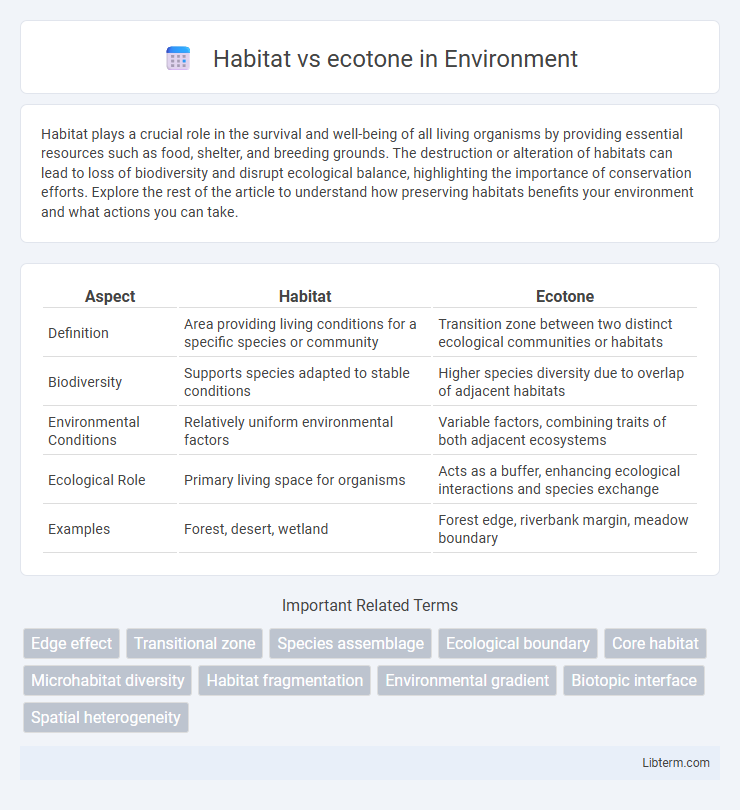Habitat plays a crucial role in the survival and well-being of all living organisms by providing essential resources such as food, shelter, and breeding grounds. The destruction or alteration of habitats can lead to loss of biodiversity and disrupt ecological balance, highlighting the importance of conservation efforts. Explore the rest of the article to understand how preserving habitats benefits your environment and what actions you can take.
Table of Comparison
| Aspect | Habitat | Ecotone |
|---|---|---|
| Definition | Area providing living conditions for a specific species or community | Transition zone between two distinct ecological communities or habitats |
| Biodiversity | Supports species adapted to stable conditions | Higher species diversity due to overlap of adjacent habitats |
| Environmental Conditions | Relatively uniform environmental factors | Variable factors, combining traits of both adjacent ecosystems |
| Ecological Role | Primary living space for organisms | Acts as a buffer, enhancing ecological interactions and species exchange |
| Examples | Forest, desert, wetland | Forest edge, riverbank margin, meadow boundary |
Understanding the Basics: Habitat and Ecotone Defined
A habitat refers to the natural environment where a specific species lives, providing essential resources such as food, shelter, and breeding grounds. An ecotone is a transitional zone between two distinct ecosystems or habitats, characterized by a unique combination of species from both adjacent areas and often increased biodiversity. Understanding the differences highlights how habitats support species survival, while ecotones serve as critical areas for ecological interactions and species adaptation.
Key Differences Between Habitat and Ecotone
Habitat refers to the natural environment where a specific species lives and thrives, characterized by consistent physical conditions and availability of resources. Ecotone is a transitional zone between two distinct ecological communities, exhibiting characteristics of both habitats and often harboring increased biodiversity. Key differences include habitat's stable and uniform conditions versus ecotone's dynamic and mixed environment, leading to distinct ecological processes and species interactions in each.
Types of Habitats in Nature
Habitats in nature encompass diverse types such as forests, wetlands, grasslands, and deserts, each providing unique biological conditions and resources for specific species. Ecotones represent transitional zones between these habitats, featuring overlapping characteristics and increased biodiversity due to the mixing of species from adjacent ecosystems. Understanding the distinctions between core habitats and ecotones is essential for effective conservation and ecosystem management strategies.
Ecotone Characteristics and Examples
Ecotones are transitional zones where two or more distinct ecosystems or habitats meet and integrate, often resulting in greater biodiversity due to the overlap of species from adjacent areas. These areas exhibit unique environmental gradients, such as variations in soil, moisture, and light, which create diverse microhabitats supporting species not typically found in the neighboring ecosystems. Examples of ecotones include the edge between a forest and a grassland, wetlands bordering rivers, and coastal mangrove zones where terrestrial and marine habitats converge.
Biodiversity: Habitat vs Ecotone Contributions
Habitats provide stable environments supporting species adapted to specific conditions, fostering biodiversity through specialized niches. Ecotones, the transitional zones between habitats, exhibit higher biodiversity due to the overlap of species from adjoining ecosystems and unique conditions promoting diverse biological communities. These edge environments often serve as hotspots for species interactions, genetic exchange, and ecological resilience.
Ecological Functions of Habitats
Habitats provide essential ecological functions such as offering shelter, food resources, and breeding grounds that support species survival and biodiversity. Ecotones, the transitional zones between distinct habitats, enhance ecological functions by promoting species diversity, facilitating nutrient cycling, and acting as buffers against environmental changes. These areas often harbor unique species assemblages and serve as critical interfaces for ecological interactions and gene flow.
The Role of Ecotones in Species Adaptation
Ecotones serve as dynamic transition zones where species adapt to diverse environmental conditions, promoting genetic diversity and resilience. These areas facilitate species interactions and resource availability that drive evolutionary processes and niche differentiation. Unlike homogeneous habitats, ecotones support unique assemblages of flora and fauna crucial for ecological adaptation and biodiversity maintenance.
Human Impact on Habitats and Ecotones
Human activities such as deforestation, urbanization, and agriculture significantly alter habitats by fragmenting ecosystems and reducing biodiversity, while ecotones--transition zones between habitats--are highly sensitive to these disturbances, often experiencing shifts in species composition and ecological functions. Pollution, invasive species introduction, and climate change exacerbate the vulnerability of both habitats and ecotones, disrupting native species interactions and ecosystem services. Effective conservation strategies must prioritize protecting these ecotones alongside core habitats to preserve ecological integrity and resilience against human-induced environmental changes.
Conservation Strategies: Protecting Habitats and Ecotones
Conservation strategies prioritize protecting habitats by preserving native vegetation and maintaining ecological processes that support species diversity. Ecotones, as transition zones with high species richness and unique biotic interactions, require targeted management to maintain their ecological functions and buffer zones from human disturbances. Integrating habitat corridors and monitoring edge effects enhances resilience and connectivity between habitats and ecotones, promoting biodiversity conservation.
Importance of Habitats and Ecotones in Ecosystem Health
Habitats provide essential living conditions for diverse species, supporting biodiversity and ecosystem stability through resource availability and shelter. Ecotones, as transition zones between different habitats, enhance species richness and ecological interactions by combining characteristics of adjacent ecosystems. Both habitats and ecotones are crucial for ecosystem health, promoting resilience, nutrient cycling, and adaptive capacity in changing environments.
Habitat Infographic

 libterm.com
libterm.com